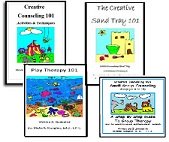Sandtray Therapy -- Cultural Symbols of Japan Miniatures
by Sherrie Bridges-Sinclair
(Macon, GA)
Cultural Symbols of Japan for Sand Tray Therapy Multicultural Midterm: The Land of the Rising Sun
Sherrie Bridges-Sinclair
Mercer University
The Japanese Fan
The folding fan was invented in Japan around the 6th to 8th century. It was a court fan called the Akomeogi after the court women's dress named Akome. According to the Song Sui (History of Song), a Japanese monk offered the folding fans (twenty wooden-bladed fans hiogi and two paper fans kawahori-ogi to the emperor of China in 988. They were made by tying thin stripes of hinoki (or Japanese cypress) together with thread. The number of strips of wood differed according to the person's rank. Later in the 16th century Portuguese traders introduced it to the west and soon both men and women throughout the continent adopted it. They are used today by Shinto priests in formal costume and in the formal costume of the Japanese court (they can be seen used by the Emperor and Empress during coronation and marriage) and are brightly painted with long tassels.
Throughout Japan’s history, both the Japanese folding fan and the Japanese hand fan have played significant roles in society and ceremonial traditions. The importance of the Japanese fan far exceeded its ability to keep people cool. It was used in an extensive range of social and court activities. The Japanese fan was also used in the military, as a way of sending signals on the field of battle. In the arts, Japanese hand fans were vital to the success of dance, the theatre and even in sumo wrestling, where the referee controls the contestants using a type of Japanese folding fan called "gumpai uchiwa", which means "military fan". Kabuki actors used Japanese hand fans in mass as well. Such artists as Kunisada created special Japanese fans for the followers of kabuki.
In France, during the last quarter of the 19th century, Japanese hand fans had gained as much popularity as in England. French artists employed Japanese folding fans in their paintings and studios as a stimulating visual effect. Edouard Manet, the famous French impressionistic artist, once painted his wife clad in a kabuki robe holding a Japanese hand fan in her right hand while a dozen Japanese wall fans decorate the wall behind her. This painting was made in 1876 and is called "The Lady with the Fans".
Japanese wall fans can easily add life to any room and can be arranged symmetrically or casually on a wall, attached to a shoji screen or even to ceilings. When not used for adornment, Japanese folding fans were being used to cool their bearers on hot days. The great and witty English writer Oscar Wilde once wrote, "in the hot summers that have become the fashion, we fan ourselves, without regard to sex or condition, with Japanese fans". Today, we are seeing a renewed interest in Japanese fans.
http://oriental-decor.com/japanese_folding_fans.php
Japanese Dress: The Kimono
KIMONO HISTORY
Kimono was originally the Japanese word for "clothing." However, today it refers to traditional Japanese robes worn almost exclusively on special occasions such as weddings, festivals, holidays, and tea ceremonies. The present style of kimono was developed during the Heian era (794 - 1192). The kimono patterns are cut using a straight-line technique, which means that the kimono can be made from a variety of textiles and worn in many layers in colder weather. Kimono are held in place with an obi--a long belt usually made of brocade--that is wrapped around a woman's waist and tied into a bow or other shape at her back. Kimono textiles vary by the season, although they are usually made of silk. In summer, a woman may wear a lighter colored, linen kimono with summer flowers and motifs while in winter, she might choose a heavier silk kimono in a subdued color.
Traditional clothing of the Edo period, (1600-1868), included the kimono and obi as we know them today. The obi did not, however, become a prominent part of a woman’s ensemble until the mid Edo period. It was then that designers, weavers and dyers all focused their talent on creating a longer, wider and more elaborate obi. Obi measurement was then standardized to 360cm long by 30cm wide.
Edo fashion was influenced by the design and style that courtesans and entertainers wear. Women of the samurai class continued to wear the simpler kosode kimono, tied together with an obi made of braided cords. Outside the samurai class, women experimented with a more elaborate kimono- the furisode, which is often seen on the Kabuki stage. Characterised by long, flowing sleeves, the furisode kimono was accented by a large, loosely tied obi.
For many years, the obi bow was tied either at the front or on the side. By the mid-Edo period, the obi bow was tied in the back position. It was said that this style started in the mid-1700s when a Kabuki actor, imitating a young girl, came on stage with his obi tied in the back. Another reason that the back position became more acceptable was that the sheer bulk of the wider obi became too cumbersome to be positioned in the front of the kimono.
The Meiji era, (1868-1912) witnessed a revolution in the textile industry with the advent of electric weaving looms and chemical dying techniques from the West. During this time, a woman's kimono ceased to be worn in the free-flowing style of the earlier days. The new fashion was to tuck the kimono at the waist to adjust the length of the kimono to the woman's height. These tucks and folds were visible and became part of the art of tying the obi.
http://www.gojapango.com/fashion/kimono_history.html
Japanese Cherry Blossoms
Cherry blossoms, or sakura, are one of the best-known symbols of Japan. The sakura, which usually bloom at the beginning of April, are representative of new beginnings; April is the month that brings a change of seasons, signifies the start of the new school year and when new employees start their jobs. Throughout Japan, many flower-viewing festivals, parties and gatherings called hanami are held at parks and other locales at which the cherry blossoms are in full bloom.
The cherry blossom holds much symbolism within Japan. According to the Buddhist tradition, the breathtaking but brief beauty of the blossoms symbolizes the transient nature of life. The flowers last for at most a few weeks, but during that time, both the mountains and the cities are full of the delicate pink flowers, be the trees wild or cultivated. “The traditional Japanese values of purity and simplicity are thought to be reflected in the form and color of the blossoms.” (Osamu, 1983) The cherry blossom is also tied with the samurai culture, representing the fleeting nature of the samurai’s life and symbolic of drops of blood. (Frederic, 2002)
Cherry blossoms have been prominent in Japanese art and culture since time unrecorded. The first mention of the blossoms appears in the first history of Japan, written in 712. (Osamu, 1983) Because the blossoms are so interwoven throughout symbolism, art and society of Japan, it is likely that these blossoms will be important to the culture as long as the trees continue to bloom each spring.
Each spring, Washington, DC's National Cherry Blossom Festival is held in commemoration of the nearly 1700 cherry trees that bloom around the Tidal Basin; the trees were a gift from Japan to the people of the United States in 1912.
Originally a sleepy Southern town, Macon has now become a bustling center of beauty and international friendship. Its roots began with a man who possessed a deep appreciation for beauty and a passion for horticulture, the late William A. Fickling, Sr ., a local realtor. While strolling about in his backyard in 1949, he discovered the first Yoshino cherry tree in Macon. He was unaware that the tree was a Yoshino species, rare to the south. During a business trip to Washington, D.C. in 1952, Mr. Fickling spotted a tree that looked exactly like the tree he had discovered in his backyard. During a return trip, he compared a cutting from his tree to those around the Tidal Basin. He learned to propagate the Yoshinos and began freely sharing them with the community. As the years passed, Macon's Yoshino cherry trees grew quickly in number, attracting the attention and admiration of long-time residents and newcomers alike.
To share with the class: Japanese Theatre
Kabuki, with its dramatic effects, is perhaps the most popular form of Japanese art. The art was developed in the 17th century and uses a combination of dramatic dialogue and dance, with traditional music and chanting as background accompaniments. Kabuki is performed exclusively by males, who are sometimes required to play female roles.
Dojoji- lover’s dance
http://youtu.be/HtPIR6ouQTk
Bunraku, or Japanese puppet theater for adults, first started in the 16th century. Each puppet is one-half to real life-size, and is operated by three puppeteers. The head puppeteer's primary job is to manipulate the puppet's facial expressions and right arm. In a production, a chanter performs the puppets' voices, with a shamisen player adding background music.
https://www.youtube.com/embed/UV938f46Wpg
Disclaimer: This website and its content is intended for trained licensed mental health professionals and school certified mental health professionals to use for their clients / students at their own discretion.
*If you ignore the disclaimer above are using these techniques on yourself and you feel any discomfort or upset it is highly suggested that you seek out a licensed mental health professional immediately.
"Beyond Art Therapy" is the concept from Dr. Stangline that combines all creative fields in therapy. It is not the traditional "art therapy" but goes beyond to include sand tray therapy, play therapy, mindfulness, meditation, color therapy, cognitive behavioral therapy, and a vast majority of other therapies.
For any other type of mental health emergency call your local 911 / Police Number immediately.
Dr. Stangline does not offer advice / suggestions to anyone who is not a professional mental health provider, or a student who is studying this field and has questions about mental health programs of study.
See our Exciting Selection of eBooks:
Award Winning:
Creative Counseling 101 eBook
Our Best Seller!

Step By Step Therapy:
Learn how to be a more Creative Therapist with the Book that started it all!
- Graduate School Counseling book used by hundreds of graduate counseling students!
- Includes full color reproducible worksheets with most activities.
- Winner of the Counselor Writer of the Year Award, 2011, Georgia Regional Award
Download Your Copy Today Only $39.95:
See Creative Counseling 101 eBook Information Here:
Get the Set
of all four
eBooks for only $98.95:
An incredible collection of how to do therapy eBooks!
A $159.80 Value,
You Save Over $60!

Get your complete set of the Creative Counseling 101.com eBooks by Dr. Michelle Stangline for only $98.95, that's less than $25.00 per eBook (Regular Price is $39.95 for each eBook.).
Your complete set includes:
- Creative Counseling 101
- Creative Group Counseling 101
- Creative Play Therapy 101
- Creative Sand Tray 101
For more information click the link below:
See Complete Set of eBooks For Sale Here:
New!!! "Beyond Art Therapy" 101 eBook
Over 300 pages of Beyond Art Therapy activities and techniques. Learn what I teach graduate counseling students!
See the link below for more information.
Only $39.95

See More Invividual eBooks For Sale:
Sand Tray Therapy 101 eBook:
Learn how to do Sand Tray Therapy or enhance your skills.

Play Therapy 101 eBook
Learn how to do play therapy or enhance your skills.

Small Group Counseling eBook For Sale:
Learn how to do creative group therapy and enhance your skills.

School Counselor Guidance Lesson & Social Stories eBook for sale:
Get a year's worth of school counselor guidance lessons with "Creative Warm & Fuzzy Classroom Guidance Lessons eBook". Introduce your students to the "Warm & Fuzzy Way". Click the link below for more information:
Warm & Fuzzy School Counselor Guidance Lessons eBook
